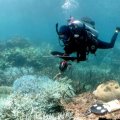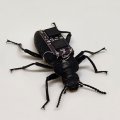Australia’s most endangered wallaby leads a lonely life until mating, when males will dig and drag their tails along the ground to woo their partner.
UQ research has shown that male bridled nailtail wallabies will stalk females for up to a week showing off the use of their hard-tipped tail, similar to a nail.
“I’ve seen males chasing after females with their tails in the ground instead of having the classic curved up shape,” UQ ecologist Dominique Sigg said.
“I saw one group do it once. . . and there was this thin clear line in the ground for about 20 metres where their nails had been.
“My interpretation of it is that the males compete for access to the females but they do not actually fight with each other directly like other macropods.
“It’s like a signalling to other males. I’ve been here and I’m really big and if I can hop really fast after this female and drag my nail in the ground, and not fall over myself, I’m stronger.”
Some researchers believed the nailtail was used to allow the wallabies to turn quickly.
Ms Sigg, who is finishing her PhD on the genetics and mating of the bridled nailtail through the School of Life Sciences, said the wallabies led a solitary life compared to their red and grey cousins who usually travelled in mobs.
“It’s a very highly structured population. They do not move very far and they breed rapidly.
“This is very unusual for a medium sized mammal.”
She has been researching the wallaby for about four years, helping transfer a population from Taunton National Park, west of Rockhampton, to Idalia National Park, south west of Blackall.
Several generations of captive bred wallabies have been released at Idalia since the first transfer in 1996.
Ms Sigg has found the Idalia wallabies were yet to recover from the 2002 drought and the genetic diversity, which indicated a healthy population, was high at Taunton but had decreased at Idalia.
Good rain is the key to a nailtail recovery at Idalia and Ms Sigg will return in October to check on their numbers.
She estimated there were about 500 wallabies at Taunton and between 300 and 400 at Idalia.
Nailtail wallabies were once common from Charters Towers to the Murray River, but only a single wild colony remains at Taunton.
It was thought the wallaby was extinct until the 1970s when a fencing contractor spotted them again around Dingo.
The wallabies were named bridled nailtail because of the distinct white stripes across their shoulders, face and tail.
They were also called the waistcoat wallaby because of their stripes, or the organ grinder wallaby, because of its dainty hops and outstretched arms.
“They’re pretty much the most endangered macropod we have in Australia,” Ms Sigg said.
For more information contact Ms Sigg (phone: 0412 037 645, email: dsigg@zen.uq.edu.au) or Miguel Holland at UQ Communications (phone: 3365 2619, email: m.holland@uq.edu.au)
.jpg)



